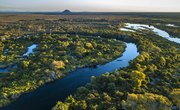
"Ecosystem" and "biome" are terms with very specific meanings for the natural world. They are similar concepts, with very different scales. Both are used by conservationists, scientists, and explorers to describe and understand the world around us. Both help people to classify and explain the way animals, people and plants interact with each other and the larger environment.
Ecosystems
Any group of organisms whose members interact with each other and their larger environment can be called an ecosystem. That means ecosystems can be very tiny or very large. A puddle where tadpoles are interacting with water, food, predators, and weather conditions can be called an ecosystem. An entire mountain chain with interacting plants, animals, forest soils, rocky mountaintops, mild foothills and ancient bedrock can be called an ecosystem, too.
Biomes
The biomes on earth are areas that have similar climate, plant and animal populations, and share geographic conditions like types of soil and plant life. Oceans, tundras, temperate forests, grasslands, tropical rainforests, and deserts are all distinct biomes. Scientists call all tropical rainforests on the planet the same kind of biome, so biomes don't have to be geographically contiguous -- that is, they don't all have to touch each other or interact directly with one another to be considered the same.
Differences
A puddle can be called an ecosystem, but the larger habitats of animals that feed on tadpoles can be called an ecosystem, too. Ecosystems, unlike biomes, do have to be geographically contiguous -- by definition, parts of an ecosystem interact, so they have to be in close proximity to each other. Biomes, which contain multiple large animal habitats and don't have to touch each other geographically, can be much larger than our little ecosystem-in-a-puddle.
How Size Matters
Biomes are never tiny. Usually, the term defines major geographic zones across the earth, so biomes equate to large swathes of the planet. According to the Franklin Institute, the whole earth could be considered a single biome when compared to another planet. Ecosystems can be either tiny or huge. So the concepts of ecosystem and biome, which divide our ecological world differently, can both be stretched to encompass the planet Earth. The biggest difference comes on the smaller end, where ecosystems can be much tinier than biomes, allowing us to see and understand the interconnected diversity in something as small as a puddle.
References
About the Author
Ellie Maclin is freelance writer with more than 10 years of experience. She contributes to online and print publications, specializing in topics such as historical places, archaeology and sustainable living. Maclin holds an M.S. in archaeological resource management from the University of Georgia, as well as a B.A. with honors in anthropology from the University of North Carolina.
Photo Credits
Hemera Technologies/AbleStock.com/Getty Images
